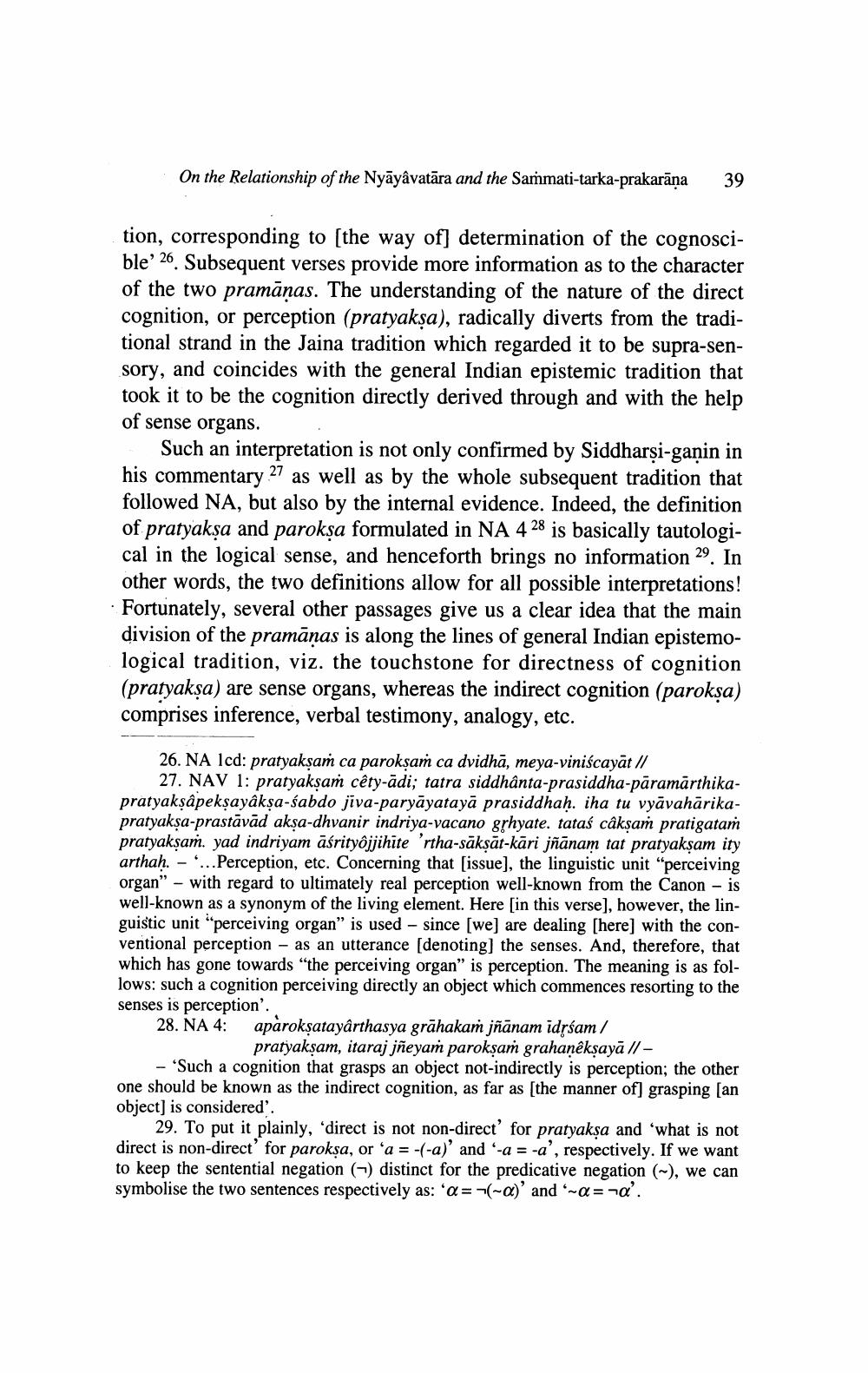________________
On the Relationship of the Nyāyâvatāra and the Sammati-tarka-prakarāna
39
tion, corresponding to (the way of] determination of the cognoscible’ 26. Subsequent verses provide more information as to the character of the two pramāṇas. The understanding of the nature of the direct cognition, or perception (pratyakşa), radically diverts from the traditional strand in the Jaina tradition which regarded it to be supra-sensory, and coincides with the general Indian epistemic tradition that took it to be the cognition directly derived through and with the help of sense organs. .
Such an interpretation is not only confirmed by Siddharsi-ganin in his commentary 27 as well as by the whole subsequent tradition that followed NA, but also by the internal evidence. Indeed, the definition of pratyaksa and paroksa formulated in NA 428 is basically tautological in the logical sense, and henceforth brings no information 29. In
other words, the two definitions allow for all possible interpretations! · Fortunately, several other passages give us a clear idea that the main
division of the pramānas is along the lines of general Indian epistemological tradition, viz. the touchstone for directness of cognition (pratyakșa) are sense organs, whereas the indirect cognition (parokșa) comprises inference, verbal testimony, analogy, etc.
sabdo jivit indriya-was-sáksāt-kátne linguisticn the Canone lin
26. NA lcd: pratyakşam ca parokşam ca dvidhā, meya-viniścayāt //
27. NAV 1: pratyakşam cêty-ādi; tatra siddhânta-prasiddha-pāramārthikapratyakşâpekşayâkșa-sabdo jiva-paryāyatayā prasiddhaḥ. iha tu vyāvahārikapratyakșa-prastāvād akşa-dhvanir indriya-vacano grhyate. tataś câkşam pratigatam pratyakşam. yad indriyam āśrityôjjihīte 'rtha-sākṣāt-kāri jñānam tat pratyakşam ity arthaḥ - ... Perception, etc. Concerning that [issue), the linguistic unit "perceiving organ” - with regard to ultimately real perception well-known from the Canon - is well-known as a synonym of the living element. Here [in this verse], however, the linguistic unit “perceiving organ” is used - since [we) are dealing (here) with the conventional perception - as an utterance [denoting) the senses. And, therefore, that which has gone towards "the perceiving organ" is perception. The meaning is as follows: such a cognition perceiving directly an object which commences resorting to the senses is perception'. 28. NA 4: aparoksatayârthasya grāhakam jñānam idrśam/
pratyakşam, itaraj jñeyam parokşam grahanêkṣayā // - - 'Such a cognition that grasps an object not-indirectly is perception; the other one should be known as the indirect cognition, as far as [the manner of) grasping [an object) is considered
29. To put it plainly, 'direct is not non-direct' for pratyakșa and 'what is not direct is non-direct' for paroksa, or a = -(-a)' and '-a = -a', respectively. If we want to keep the sentential negation (-) distinct for the predicative negation (~), we can symbolise the two sentences respectively as: 'a= (-a)' and '-arna'.




